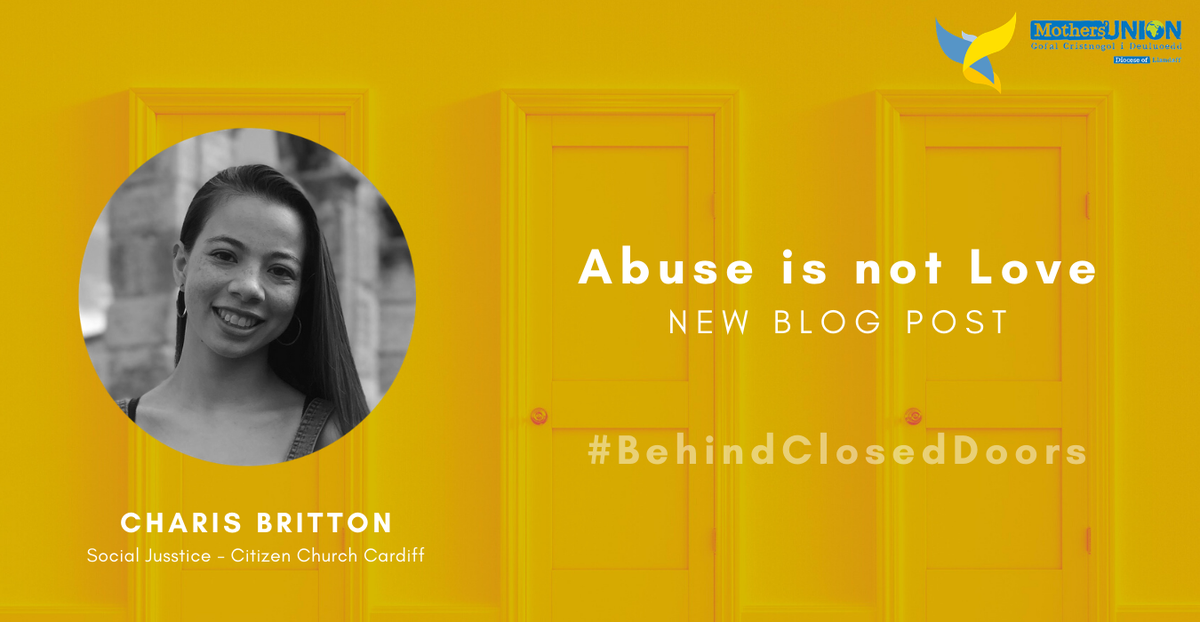Abuse is not Love
As part of our new campaign, #BehindClosedDoors, we've invited a series of guests to write blog posts for us on the topic of domestic abuse. We understand this is a deeply personal and sensitive topic, if you feel reading this blog post will be traumatising for you in any way, we advise caution. However, we are committed to opening the door on domestic abuse in our communities and we urge you to have these difficult conversations in our churches. You can find a host of resources to help you get started and advice on steps to take if you are concerned for yourself or someone you know.
If you want to become involved in our campaign, you can do so through social media or by submitting a blog post to our Digital Communications Officer.

Domestic abuse is not a new topic and it can be easy to presume that we live in a society where people are aware of what abuse looks like and how to avoid or escape it. However, it can get confusing when Hollywood and Netflix promote films such as the 50 Shades trilogy and 365 days. Films that portray unhealthy and abusive relationships in such a way that they become fantasies amongst their audience. Films that have been criticised (understandably) for glamorising such toxic and controlling behaviour, and yet, has been met with fierce debates from fans who idealise the “manly” traits of the possessive protagonist. This is causing certain forms of abuse to become increasingly normalised. Several videos inspired by 365 days went viral on TikTok, which shows how rapidly its messages are spreading through younger generations. One of the film’s most infamous scenes has resulted in male TikTok users pretend to grab their partners by the throat. 50 Shades is no different; it’s a #metoo experience dressed up as a romantic fantasy/love story.
Abuse is not sexy. The number of instances where abuse is brushed over or romanticised could fill another blog post, organisations, such as Fight the New Drug, have written such an article (amongst many others) and I would 100% recommend checking them out on their website or Instagram. When physical and sexual abuse can be so blatantly disregarded by society, it is unsurprising that other types of abuse are consistently overlooked and ever understood. One of which is: coercive control.
In December 2015, England and Wales introduced the Serious Crime Act that made “controlling or coercive behaviour” in personal relationships illegal. They defined coercive control as a “continuing act, or pattern of acts, of assault, threats, humiliation and intimidation or other abuse that is used to harm, punish, or frighten their victim”; in other words, it is a pattern of deliberate abuse over time that leaves the victim intimidated, dependent, and isolated. 5 years on and 85% of my friends (aged 20-28, male and female) still cannot define what coercive control is.

If you cannot identify what the issue is, how could you possibly expect to know if you or someone else is falling victim to it? Coercive control can look like someone being isolated from friends or family, being told what they can and can’t wear, or having what they do with their time monitored. Identifying features like these is crucial for being able to understand if a relationship is abusive.
How many of us have sat and listened to friends make comments like “oh he/she wouldn’t want me to wear that” or “my partner doesn’t think I should talk to that person”? In some cases, this may be a one-off comment arising from a valid concern, such as a partner not approving of a toxic friendship. Yet, if a person is consistently controlling what their partner does, this is a crime. It is not a communication error; it is not an overreaction from the victim; it is a crime. Many relationships start with compliments, care and charisma so it can be difficult for those in the situation to acknowledge when it becomes manipulative. For others, coercive control is part of a cycle. I’m reminded of a quote in The Great Gatsby that says that we all accept the love we think we deserve; if people grow up in abusive situations they won’t necessarily realise when a situation is abusive. All people have a right to live a life free from manipulation and as a Church we are called to love and support one another. We need to model what this looks like so that people and society can see how a world without abuse should be.
What is the solution? For individuals, checking in on friends who seem as though they’re withdrawing and becoming dependent on their partner can be crucial. If you find yourself being victimised then, difficult though it can be, reaching out for help is a vital step. To enable this, creating and extending refuge centres needs to be prioritised. As with all types of abuse, the idea of coercive control is one which people need to be educated on. Accordingly, schools, Churches, and other institutions need to have clear safeguarding policies for what to do when such control is suspected. We get the “sex talk” at school but it’s time for the “healthy relationship discussion”. With divorce rates at 45% and abuse being frequently unreported, it is time to focus on teaching. It is time to normalise speaking up about manipulation in relationships instead of trivialising and dismissing it. It is time to change.